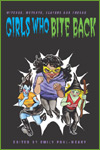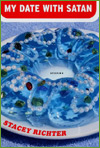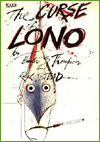 |
|||||||||||||
|
|
|||||||||||||
   
|
Published Literature (continued...) Pohl-Weary, Emily, editor. Girls Who Bite Back: Witches, Mutants, Slayers, and Freaks. (Sumach Press, 2004) This terrific Canadian anthology is both an homage to, and examination/critique of, the kick-ass grrrls and female superheroes that are increasingly evident in popular culture, from mythic heroines to comic book superbabes to Buffy the Vampire Slayer. The book is interdisciplinary and interstitial in construction, featuring essays, memoirs, poetry, art, comics, a scientific report, a fictional online chat, and some great new fiction by Nalo Hopkinson (Brown Girl in the Ring, The Salt Roads); Kij Johnson (The Fox Woman, Fudoki), Larissa Lai (When Fox Was a Thousand, Salt Fish Girl), Hiromi Gotto (The Kappa Child, Chorus of Mushrooms), and other notable Canadian and American authors. "I approached several writers and artists and told them I wanted to create a book I would have loved to read as a teenager and that my friends and I would like to read now," says Pohl-Weary in the book's introduction. "The response was incredible... Some writers decided to critique existing characters and others invented new, better, more interesting superheroes. Regardless of how inspiration presented itself, the consensus among writers and artists was that no one had ever heard of a book like this before. We were going to delve into the paradox and revel in it, through critical and personal essays, fiction, art and hybrid forms." For more information on the book and its contributors, visit the Girls Who Bite Back web site. (Terri Windling) Richter, Stacey. My Date with Satan. (Scribner, 2000) This collection of short stories originally appeared in 1999, and the stories contained within it are weird and wonderful. Five years later they still feel fresh and crisp. Stacey's Richter's stories explore the disenchanted, disenfranchised, and misanthropic youth culture of the nineties. In these stories you will find sado-masochists who meet online and turn out to be much duller in person, rich girls who appropriate commercial ghetto identities, ghosts hanging out in bars, a boy whose stepmother and father belong to a New Age cult, and high school teachers who buy drugs from their students. The situations are almost always absurdist in nature, but Richter somehow manages to capture a tone which enables her to make us feel for these characters as much as we want to laugh at them or even despise them. Her main trick is the first-person narrative, in which the narrator is in a necessary denial, though is convinced otherwise, and is convincing to the reader as well, for when the truth behind their circumstance is revealed, the reader will often be as shocked as the character. Using pop culture references and stereotypes, Stacey Richter has managed to truly make the stuff of tabloids seem possible. Her idiosyncratic voice allows her to bring together a lot of disparate materials, as well as disparate genre concepts, and meld them into something altogether singular. Several other Richter's stories have appeared in recent years, most notable "The Cavemen in the Hedges" and "Twin Study", published in Zoetrope. Both new stories continue her vision of an off-kilter world, careening towards something apocalyptic, but told in a manner which implies that the end of something is always really a new beginning. Hopefully another collection or a novel will be coming in the near future. This is a writer whose work must be passed around by word of mouth, not only kept alive, but prosperous. (Christopher Barzak) Thompson, Hunter S. Curse of Lono. (Bantam, 1982) The good doctor has concocted a lengthy career dedicated to fouling up readerly expectations, and nowhere does he do it better than in Curse of Lono. This book might be shelved under Sports (chapters first appeared in Running magazine), Journalism, Creative Non-fiction, and with its high regard for Hawaiian folklore, it certainly deserves to be the centerpiece in discussions of myth's relationship to interstitial fiction.While covering the Hawaii Marathon, Thompson plies his brand of boozy gonzo journalism only to find himself, as usual, covering an entirely different event, one in which local legend claims Thompson as the long-lost Hawaiian god Lono. To this day, Thompson asserts that the events of this novel really happened and that he is Lono. Consequently, this book's interstitiality reaches right across questions of categorization, myth/genre, journalistic integrity, and, like much of Thompson's work, grasps at redefining "truth." (Barth Anderson) Wexler, Robert Freeman. In Springdale Town. (PS Publishing, 2003) Wexler writes of small-town America with the same regard to detail and unnerving surreality as David Lynch. Just when you think you have a grip on what's happening in Springdale town, its two main characters, and the story's plot, Wexler rearranges the whole game with, I have to say it again, Lynchian instinct. With footnotes inset to give the page an air of scholarly work, In Springdale Town can't be neatly fit into the typical contemporary fantasy molds, since as a metafiction, its audience seems to be dwelling outside typical genre boundaries. (Barth Anderson) Websites: Fiction Online Born Magazine This is an amazing site — and talk about interstitial! A quarterly literary arts journal, Born Magazine presents in flash versions works that are collaborations between writers, artists, musicians and web designers. Each piece is a marvel of technology, text, art and music, all integrated into a single presentation. It is absolutely captivating — but definitely requires a DSL line or some other fast loading service for your computer. (Midori Snyder) Café Irreal This is another fascinating literary website, devoted to a wide range of literary ideas. It provides some of the most engaging short-short fiction from an international collection of new authors as well as a collection of heady theoretical essays. If you are an educator, this is a great site to direct students (high school and above) to find stories that interest them. I tried this and was quietly pleased to discover the following day in class my high school students eagerly sharing their finds with each other, rather than dutifully reporting to me. (Midori Snyder) Words Without Borders This online journal offers an extraordinary array of international short fiction and essays. About their site they write, "Words Without Borders undertakes to promote international communication through translation of the world's best writing--selected and translated by a distinguished group of writers, translators, and publishing professionals--and publishing and promoting these works (or excerpts) on the web. We also serve as an advocacy organization for literature in translation, producing events that feature the work of foreign writers and connecting these writers to universities and to print and broadcast media." (Midori Snyder) Past Recommendations, Winter 2003 Back to the top |
||||
| previous page 1 | 2 | |||||